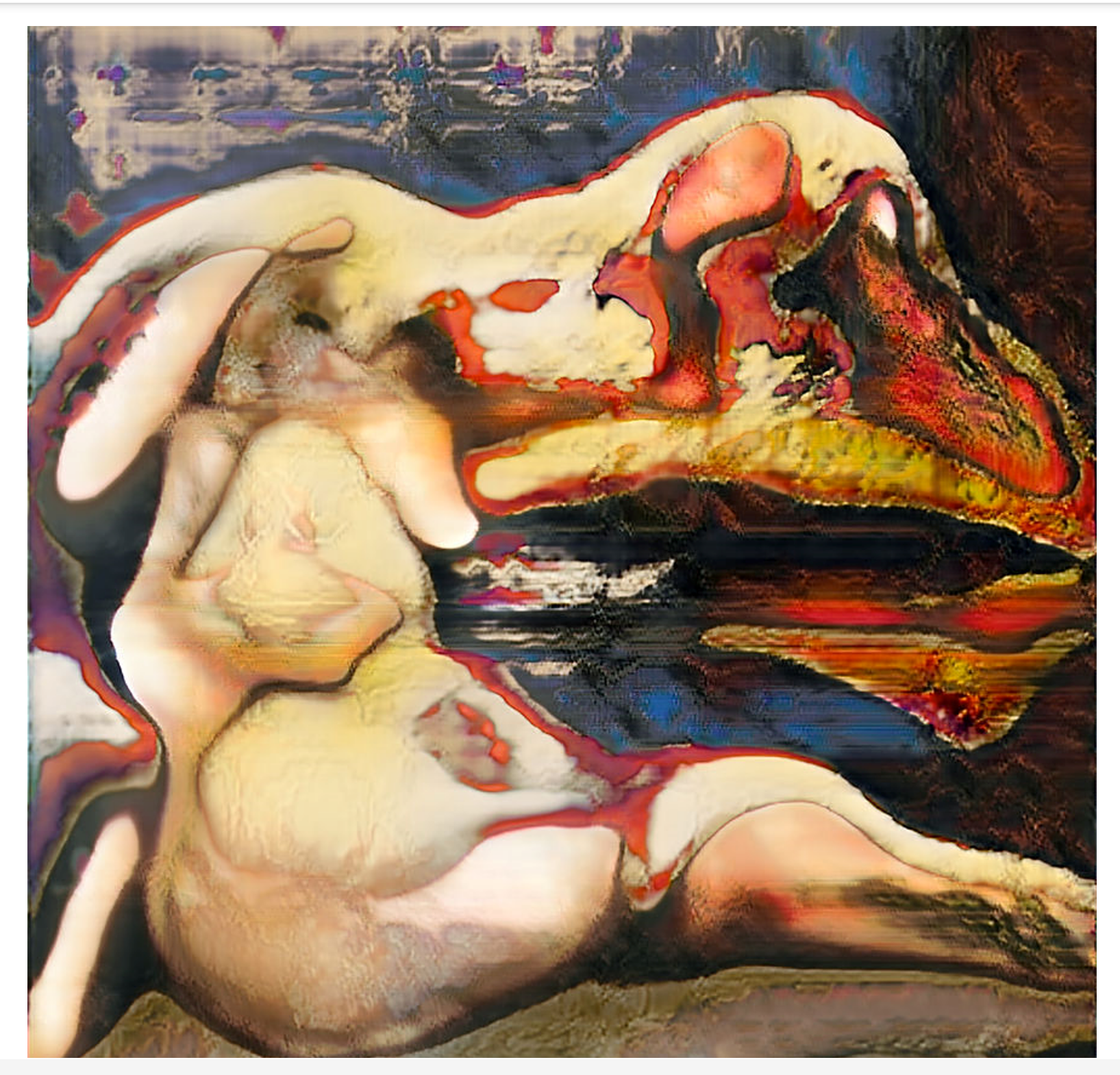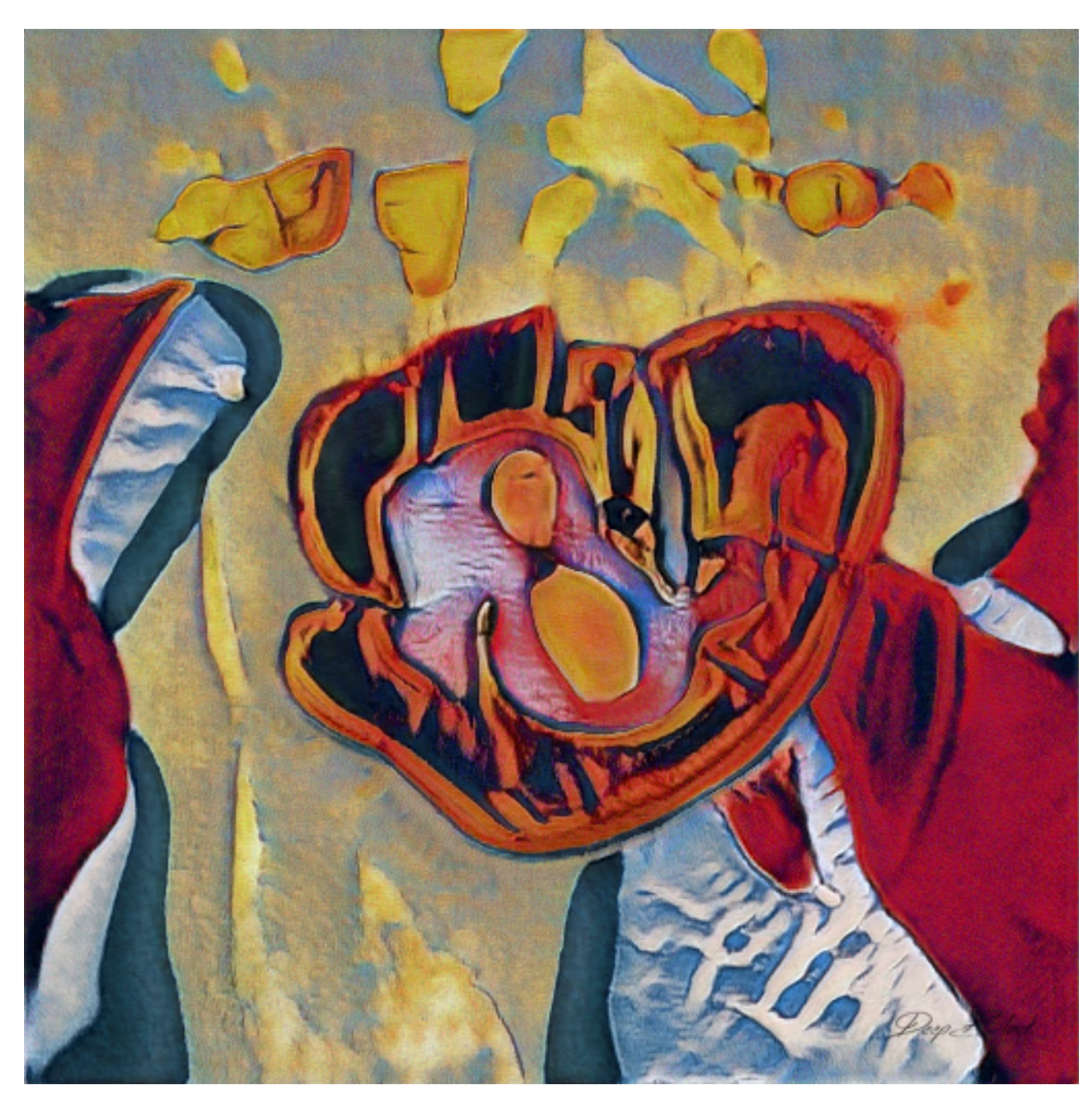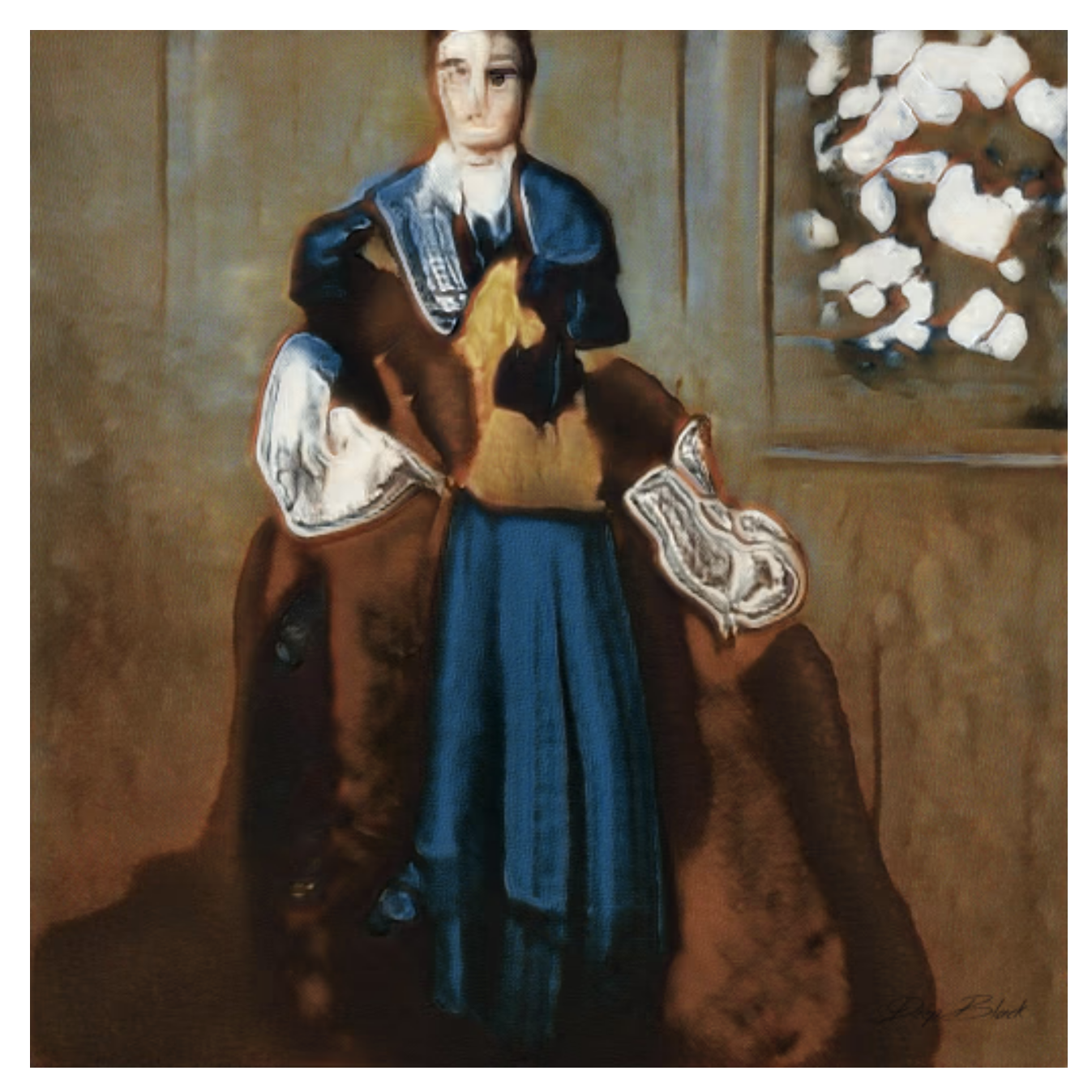In the world of NFTs, the only thing hotter than a digital nude portrait is an abstract, algorithmically generated digital artwork. And as luck would have it, the latter owes its existence to the former.
But the majority of the original 300 hot digital nudes were thrown in the dumpster.
Now they are worth millions and not an easily accessible collectible; however, they lead us directly to Deep Black, currently within reach around one ETH.
But enough with the rhyming.
Let's step back for a moment and get the story straight in this topsy turvy NFT world, so our snarky readers can see the thread of historical significance that weaves these collections together and why we think there might be a lot of undervalued NFT upside here.
It all started in 2017 with young art prodigy Robbie Barrat's AI Generated Nude NFT collection, a series of digital artworks created entirely by a machine learning algorithm trained on thousands of nude paintings.
The method he used is known as general adversarial networks (GAN)s: two neural networks that compete with each other.
But deep GANS also complete each other.
They are not just copying or classifying, but rather creating new AI artworks that never existed before.
The first one is fed the data; in this case, Robbie uploaded 10,000 nudes. Now the network has the ability to determine or "discriminate" what images are "authentic" or "real."
Then the second "creator" network makes art in the style of the original data set and sends these attempts to the "discriminator" network to see if they pass. As the discriminator network rejects the creator network's impersonation attempts as not being "authentic" enough, the creator network gets better and better until eventually these "inauthentic" impersonating artworks fool the discriminator network into thinking they are a part of the original ones. Still with me?
As the GANs go about fighting with each other, Robbie then purposefully added glitches to the programs to make the final results more interesting.
"My interest was: can I use these tools to make something not classical?" he told AFP in a video interview.
While many news articles said that the networks are autonomously creating the artwork, Robbie points out that it is rather a co-creation:
- A human chose the data set
- A human designed the network
- A human trained the network
- A human curated the resulting outputs
So a human sets up the system and curates the output, but the machines run independently.
Whatever your views are on how much of a "co-creation" this really is, one can't deny that the results of Robbie's system are incredible, as the AI developed its very own surreal vision of a human body.
The images have a distinctly fleshy, organic, voluminous vibe, very much in the style of Francis Bacon.

Robbie was the first artist to allow buyers to mint (turn into NFTs) his works on SuperRare, which led to him connecting with Christie's Jason Bailey.
Baily recognized Robbie's nascent potential and invited him to give a tech talk where each of the attendees would walk away with a credit card sized coupon in a gift bag that had a printed link to one of his 300 AI Generated Nude NFTs.
"I was telling everybody from the stage: "This is the future, don't throw these cards away.."
However this was 2018. It was also the traditional art market set. At one of the oldest, most established auctioneer houses.
Not to mention that Robbie was still in high school.
And Take It or Leave It also experienced the same exact reaction multiple times in the midst of the biggest NFT art boom in history at the most progressive Art Basel Miami 2022 show.
So there are always missed opportunities that collectors can't see.
In any case, 288 of the 300 were trashed and the value of these "Lost Robbies" continues to rise in fame and fortune to extraordinary levels.
That is partially why we see such high prices for these fleshy blobs: i.e. Nude #7 sold in 2021 for $636,200 ~210ETH
But it is not the whole story.
In addition to being very rare, these remaining 12 were also one of the very first collections ever minted on SuperRare, one of the very first created by AI, and one of the very first to appeal to a new type of collector who buys based on technical transcendence.
So his works have historical significance as well as a collecting ready crowd that appraises works based on coding as well as aesthetics.
Roses
In addition, his personal brand building was cemented with his prolific output while still in his teens. He created multiple outstanding AI projects as diverse as a Kayne West RapBOT as well as a collab with fashion house Balenciaga.
Most importantly, he pushed his GANs code to GitHub, a code sharing platform.
And made it open source.
Then three enterprising young AI artists who call themselves Obvious leveraged his code to create the Portrait of Edmond Belamy, which subsequently sold at Christie's for $432,500. The sale is not only unusual because it was the first AI artwork ever sold by the 252-year-old auction house, but because the expected price for the print was between $7,000 and $10,000.
Due to the price points involved, Portrait of Edmond Belamy quickly gained fame, raising questions about the intersection of art and technology and challenging traditional notions of what constitutes art.
It also raised eyebrows because the three 25 year-olds did not publicize the fact that they had used Robbie's code, only enhancing it with a historical painting dataset scraped freely from the internet.
They did, however, spend a year pushing the idea of AI democratizing art through attention grabbing press releases showing Belamy "family" portraits.
But while some critics dismissed the collection as little more than a gimmick and probably destroyed future sales, others looked past the PR and saw the potential for AI-generated art to push the boundaries of creativity and expression.
Among these visionaries was a community of artists and AI researchers who were inspired by Robbie's work to both collect and explore the possibilities of GANs, and affectionately call themselves the GANGang.
The result of their efforts was the Deep Black NFT Collection, a stunning series of abstract digital artworks created using GANs to generate unique shapes and colors.
Similar to Robbie's Nudes and Obvious' Portrait of Edmond Belamy, the Deep Black NFT Collection challenges traditional notions of what art can be, using technology to blur the line between human creativity and machine intelligence.
The artworks feature abstract shapes and colors that were generated by the AI, and the collection as a whole is intended to explore the relationship between AI and human creativity.


Here at Take It or Leave It we had a lot of fun of exploring the collection, trying to decide which famous artworks influenced which output.
But it is also still very much an AI in training, trying to get the details right.
Which makes it a historically significant collection, just like the previous two.
Deep Black has also said on their website that
Ownership of the DeepBlack smart contract has been renounced. This zero address is the only one able to withdraw funds or mint new artworks. Therefore, you can collect DeepBlack with the confidence that no more DeepBlack artworks will ever be created.
Which enables these 3,073 NFTs to continue to be rare in perpetuity.
Now we already know how the AI created NFTs made by Robbie and Obvious and trained on historical artworks ended up.
"To the moon" one could say...
But Deep Black has been waiting patiently in the wings, with many of the same exact characteristics but relatively undiscovered.
The 3,073 NFTs were all minted on the Ethereum blockchain in September 2019, and ownership sits currently at 709 owners with only 4% listed.
And while they are not the first AI artist, their claim to fame is that they were the first art collection done end to end by AI with no human interaction in either creating or curating the works.
So a second reason for rarity and historical significance.
So why were DeepBlack NFTs suddenly sold 45 times in the last 7 days? And why does the floor price keeps rising with the average already at $2,500?
Unlike the Portraits of the Belamy's, the Deep Black collection did not have a year long PR campaign, and therefore probably did not get anywhere near the press required to get the flywheel of fame spinning when it launched to the world in 2019.
Then in January of 2022 Beeple created an NFT called Deep Black and Deep Black in return re-created his piece by using all 3,073 Deep Black NFTs in a collage.
Yet still no noticeable uptick.
So here at Take It or Leave It we have a few ideas on what potential additional factors might be influencing Deep Black's current rising price, volume, and fame.
First of all, famous NFT artist collectors, such as Coldie, started to Tweet about it. In addition, it was mentioned as a good pick for under one ETH by Eli Scheinman.
So maybe it is a combination of timing and luck to get plucked from obscurity and pushed on Twitter by NFT influencers at just the right moment.
Even more importantly is that the technocrat collector is one of the main driving forces behind NFTs right now, and they are more likely to value historically significant moments in terms of AI.
And, last but not least, we already mentioned that these 3,073 will be the only ones ever made by Deep Black as well as the first ones to be made entirely end to end by AI.
So once there is a little hype, then the unique attributes may increase its perceived value and get the flywheel of fortune and fame spinning.
While we would agree that not all the artworks are aesthetically pleasing, if we optimize on the other factors impacting valuation, and then also find a beauty, we will have a truly rare NFT.
And while both collections were created using AI algorithms, they are quite different in terms of their style, subject matter, and artistic intent. The Deep Black AI collection is more abstract and experimental, while Robbie's collection is more representational and provocative. Additionally, the Deep Black AI collection was created by a team of artists and AI researchers, while Robbie's collection was created by an individual artist.
And yet, one clearly leads to the other.
But will the price points follow?
They have 3,704 Followers on Twitter, 1408 on Discord
Due to their historical significance, a few famous collectors, the flywheel of fame starting to spin, as well as a lot of upside potential based on prices of similar AI artworks, the Deep Black Collection gets a Cecily Score of 8/10
Take It or Leave It?!


by Cecily Lough

